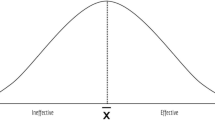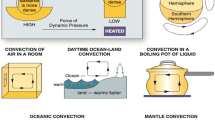Abstract
This essay describes the principles of Direct Instruction design and delivery used to establish clear, unambiguous communication and maximize student responding. Direct Instruction research findings are summarized: achievement of low-income students in Follow Through, longitudinal results, and the effectiveness of Direct Instruction for students with handicaps. Finally, new directions for Direct Instruction, technological applications and instruction of higher-order skills, are discussed.
Similar content being viewed by others
References
Abt Associates. (1976).Education as experimentation: A planned variation model (Vol. III). Cambridge, MA: Abt Associates.
Abt Associates. (1977).Education as experimentation: A planned variation model (Vol. IV). Cambridge, MA: Abt Associates.
Becker, W. C. (1977). Teaching reading and language to the disadvantaged: What we have learned from field research.Harvard Education Review, 47, 518–543.
Becker, W. C. (1978). The national evaluation of Follow Through: Behavior-theory-based programs come out on top.Education and Urban Society, 10, 431–458.
Becker, W. C., & Carnine, D. W. (1980). Direct instruction: An effective approach to educational intervention with the disadvantaged and low performers. In B. B. Lahey & A. E. Kazdin (Eds.),Advances in clinical child psychology (Vol. 3, pp. 429–473). New York: Plenum Publishing Corporation.
Becker, W. C., & Engelmann, S. (1978).Analysis of achievement data on six cohorts of low-income children from 20 school districts in the University of Oregon Direct Instruction Follow Through Model. (Technical report 78-1). Eugene, OR: University of Oregon.
Becker, W. C., & Gersten, R. (1982). A follow-up of Follow Through: The later effects of the direct instruction model on children in fifth and sixth grades.American Educational Research Journal, 19, 75–92.
Brophy, J. E. & Good, T. L. (1986). Teacher behavior and student achievement. In M. C. Wittrock (Ed.),Handbook of Research on Teaching. New York: Macmillan.
Carnine, D. W. (1976). The effects of two teacher presentation rates on off task behavior, answering correctly, and participation.Journal of Applied Behavioral Analysis, 9, 199–206.
Carnine, D. W. (1980). Phonic versus whole-word correction procedures follow phonic instruction.Education and Treatment of Children, 3, 323–330.
Carnine, D. W. (1981). High and low implementation of direct instruction teaching techniques.Education and Treatment of Children, 4, 42–54.
Carnine, D. (1984). Mainstreaming computers.Educational Leadership, 41(8), 77–82.
Carnine, D. W., Kameenui, E. J., & Maggs, A. (1982). Components of analytic assistance: Statement saying, concept training, and strategy training.Journal of Educational Research, 75, 374–377.
Collins, M., & Carnine, D. (1988). Evaluating the field test revision process by comparing two versions of a reasoning skills CAI program.Journal of Learning Disabilities, 21, 375–379.
Collins, M., Carnine, D., & Gersten, R. (1987). Elaborated corrective feedback and the acquisition of reasoning skills: A study of computer-assisted instruction.Exceptional Children, 54, 254–262.
Darch, C., & Carnine, D. (1986). Approaches to teaching learning-disabled students literal comprehension during content area instruction.Exceptional Children, 53, 240–246.
Darch, C., Carnine, D., & Kameenui, E. (1986). The role of visual displays and social structure in content-area instruction.Journal of Reading Behavior, 18, 275–295.
Day, H. M., & Horner, R. H. (1986). Response variation and the generalization of dressing skills.Applied Research in Mental Retardation, 7, 189–202.
Dimino, J., Gersten, R., Carnine, D., & Blake, G. (in press). Using story grammar to promote ninth graders' comprehension of literature.Elementary School Journal.
Dixon, B. (1978).Teaching spelling. Unpublished manuscript. Eugene, OR: Division of Teacher Education, University of Oregon.
Dunn, L. M., & Smith, J. O. (1966).Peabody language development kit. Circle Pines, MN: American Guidance Service, Inc.
Engelmann, S., Becker, W., Haner, S., & Johnson, G. (1979).Corrective reading. Chicago: Science Research Associates.
Engelmann, S., & Bruner, E. C. (1988).Reading mastery. Chicago: Science Research Associates.
Engelmann, S., & Carnine, D. (1981).Corrective mathematics. Chicago: Science Research Associates.
Engelmann, S., & Carnine, D. (1982).Theory of instruction. New York: Irvington.
Engelmann, S., & Osborn, J. (1976).Distar language. Chicago: Science Research Associates.
Englemann, S., & Carnine, D. (1991).Connecting math concepts. Chicago: Science Research Associates.
Gange, E. (1985).The cognitive psychology of school learning. Boston: Little Brown & Company.
Gersten, R. (1985). Direct Instruction with special education students: A review of evaluation research.Journal of Special Education, 19, 41–58.
Gersten, R., Becker, W. C., Heiry, T. J., & White, W. A. T. (1984). Entry IQ and yearly academic growth of children in Direct Instruction programs: A longitudinal study of low SES children.Educational Evaluation and Policy Analysis, 6(2), 109–121.
Gersten, R., Carnine, D., & Williams, P. (1982). Measuring implementation of a structured educational model in an urban school district: An observation approach.Education Evaluation and Policy Analysis, 4, 67–79.
Gersten, R., Darch, C., & Gleason, M. (1988). Effectiveness of direct instruction academic kindergarten for low-income students.The Elementary School Journal, 89, 227–240.
Gersten, R., & Keating, T. (1987). Improving high school performance of “at-risk” students: A study of long-term benefits of direct instruction.Educational Leadership, 44(6, 28–31.
Greenwood, C. R., Delquardi, J. C., & Hall, R. V. (1984). Opportunity to respond and student academic performance. In W. L. Heward, T. E. Heron, D. S. Hill & J. Trap-Porter (Eds.),Focus on Behavior Analysis in Education (pp. 58–88). Columbus, OH: Merrill Publishing Company.
Grossen, B., & Carnine, D. (1990). Diagramming a logical strategy: Effects in difficult problem types and transfer.Learning Disability Quarterly, 13, 168–182.
Gurney, D., Gersten, R., Dimino, J., & Carnine, D. (1990). Story grammar: Effective literature instruction for high school students with learning disabilities.Journal of Learning Disabilities, 23, 335–342.
Haney, W. (1977).A technical history of the national Follow Through evaluation. Cambridge, MA: Huron Institute.
Hayden, M., Wheeler, M., & Carnine, D. (1989). The effects of an innovative classroom networking system and an electronic gradebook on time spent scoring and summarizing student performance.Education and Treatment of Children, 12, 253–264.
Hofmeister, A., Engelmann, S., & Carnine, D. (1989). Developing and validating science education videodiscs.Journal of Research in Science Teaching, 26(7).
Horner, R. H., & Albin, R. W. (1988). Research on general-case procedures for learners with severe disabilities.Education & Treatment of Children, 11, 375–388.
Horner, R. H., Albin, R. W., Ralph, G. (1986). Generalization with precision: The role of negative teaching examples in the instruction of generalized grocery item selection.Journal for the Association of Persons with Severe Handicaps, 11, 300–308.
Horner, R. H., & McDonald, R. S. (1982). A comparison of single instance and general case instruction in teaching a generalized vocational skill.Journal of the Association for Persons with Severe Handicaps, 7(3), 7–20.
House, E. R., Glass, G. V., McLean, L. D., & Walker, D. F. (1978). No simple answer: Critique of the Follow Through evaluation.Harvard Educational Review, 48, 128–160.
Kelly, B., Carnine, D., Gersten, R., & Grossen, B. (1986). The effectiveness of videodisc instruction in teaching fractions to learning-disabled and remedial high school students.Journal of Special Education Technology, 8(2), 5–17.
Kinder, D., & Bursuck, W. (in press). The search for a unified social studies curriculum: Does history really repeat itself.Journal of Learning Disabilities.
Lloyd, J., Cullinan, D., Heins, E. D., & Epstein, M. H. (1980). Direct Instruction: Effects on oral and written language comprehension.Learning Disabilities Quarterly, 3, 70–76.
Lloyd, J., Epstein, M. H., & Cullinan, D. (1981). Direct teaching for learning disabilities. In J. Gottlieb & S. Strichort (Eds.),Perspectives on handicapping conditions: Current research and application in learning disabilities. Baltimore, MD: University Park Press.
McDaniels, G. L. (1975). The evaluation of Follow Through.Educational Researcher 4, 7–11.
Maggs, A., & Morath, P. (1976). Effects of direct verbal instruction on intellectual development of institutionalized moderately retarded children: A 2-year study.Journal of Special Education, 10, 357–364.
Moore, L., & Carnine, D. (1989). Evaluating curriculum design in the context of active teaching.Remedial and Special Education, 10, 28–37.
Moore, L., Carnine, D., Stepnoski, M., & Woodward, J. (1987). Research on the efficiency of low-cost networking.Journal of Learning Disabilities, 20, 574–576.
Niedelman, M. (in press). Problem solving and transfer.Journal of Learning Disabilities.
Patching, W., Kameenui, E., Carnine, D., Gersten, R., & Colvin, G. (1983). Direct instruction in critical reading.Reading Research Quarterly, 18, 406–418.
Prawat, R. S. (1989). Promoting access to knowledge, strategy, and disposition in students: A research synthesis.Review of Educational Research, 59, 1–42.
Resnick, L. B. (1987).Education and learning to think. Washington, D.C.: National Academy Press.
Ross, D., & Carnine, D. W. (1982). Analytic assistance: Effects of example selection, subjects age, and syntactic complexity.Journal of Educational Research, 75, 294–298.
Skemp, R. R. (1978). Relational understanding and instrumental understanding.Arithmetic Teacher, 26, 9–15.
Sprague, J., & Horner, R. H. (1984). An experimental analysis of generalized vending machine use with severely handicapped students.Journal of Applied Behavior Analysis, 17, 273–278.
Stein, C. L., & Goldman, J. (1980). Beginning reading instruction for children with minimal brain disfunction.Journal of Learning Disabilities, 13, 52–55.
Systems Impact. (1991).Geometry. Gaithersburg, MD: Author.
White, W. A. T. (1988). A meta-analysis of the effects of direct instruction in special education.Education & Treatment of Children, 11, 364–374.
Woodward, J., Carnine, D., & Gersten, R. (1988). Teaching problem solving through computer simulations.American Educational Research Journal, 25, 72–86.
Woodward, J., Carnine, D., Gersten, R., Moore, L., & Golden, N. (1987). Using computer networking for feedback.Journal of Special Education Technology, 8(4), 28–35.
Woodward, J., & Noell, J. (in press). Science instruction at the secondary level: Duplications for students with LD.Journal of Learning Disabilities.
Author information
Authors and Affiliations
Rights and permissions
About this article
Cite this article
Kinder, D., Carnine, D. Direct instruction: What it is and what it is becoming. J Behav Educ 1, 193–213 (1991). https://doi.org/10.1007/BF00957004
Accepted:
Issue Date:
DOI: https://doi.org/10.1007/BF00957004




